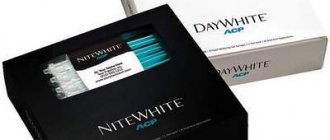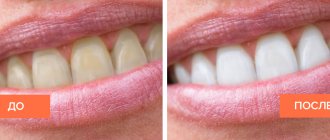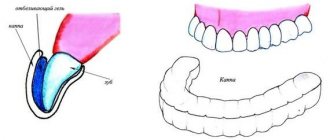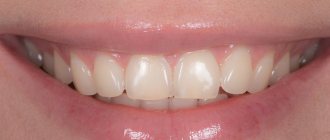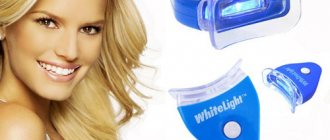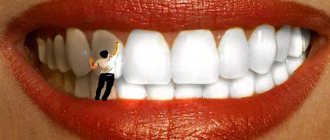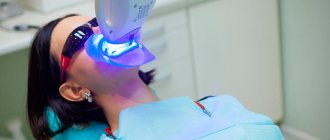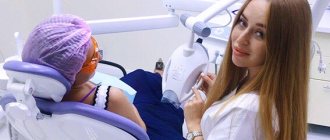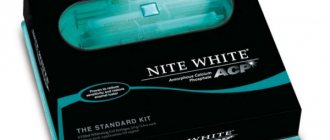Zoom 4 is a professional whitening system from Philips. The main difference from previous versions is a more gentle effect on tooth enamel and, as a result, greater safety. Allows you to lighten teeth up to 8 tones, while reducing the period of hypersensitivity after the procedure to 10-12 hours.
- What is Zoom 4 technology
- Advantages of Zoom 4 technology
- Indications and contraindications for teeth whitening
- How is the teeth whitening procedure performed?
- Whitening results: “before” and “after”
- Cost of whitening Zoom 4
- Promotion - all preparatory services are free!
- Doctors performing teeth whitening
- Reviews from our patients
- Sign up for a consultation
What is Zoom-4
Whitening Zoom-4 is a cosmetic procedure for lightening tooth enamel by exposing it to chemical ingredients. The technique is an improved version of the Zoom-3 technology. Its advantage is a more gentle effect on the teeth (the top layer is not destroyed) and a reduced process time. The main active element that penetrates the enamel and discolors it is hydrogen peroxide, more precisely, one of its forms is carbamide peroxide. Standard concentration is 25%. It is safe and has no harmful effects on the body (when used externally).
During the procedure, the dentist uses a special lamp to activate a chemical reaction. This lamp has the option of regulating the light flow modes. The doctor can choose the optimal one for the conditions of a particular clinical case in order to increase the comfort of the process for the patient. Under the influence of radiation, atomic oxygen is released from hydrogen and penetrates the pores of tooth enamel, destroying pigment cells by an oxidative cleavage reaction.
Important: dentists recommend that patients with serious discoloration of teeth use not only clinical whitening, but also supplement it with home whitening. The doctor gives out a dental guard and chemical reagents in syringe tubes, and talks about the sequence of actions. The intensity of home manipulations is weaker, so the risk of accidental chemicals. burns are excluded if the given recommendations are followed.
Paste: abrasive or peroxide
The high price (from 350 rubles per tube) and the inscription “Whitening” (whitening) do not guarantee that this is a paste that can change the color of your teeth. Carefully study its composition: if it contains abrasive particles (flint, soda, etc.) - it is a plaque fighter. Essentially, it works like dishwashing powder: it mechanically removes deposits from the surface using rough granules. But the enamel is not bleached, but simply returns to its original state. Pastes containing hydrogen or urea peroxide act differently: unlike abrasives, they work not on the surface of the teeth, but on the upper layers of enamel. These chemicals decolorize accumulated organic food dyes and then remove them. This will lighten the teeth a little. By the way, it is in your interests to give preference to hydrogen peroxide: it is three times stronger than urea. But keep in mind: you shouldn’t expect that after a few days of using such pastes your smile will become like Whitney Houston’s. You can only whiten your teeth a little. Only regular use of whitening pastes can lead to more or less noticeable results. True, if you brush your teeth with them every day, you risk increasing sensitivity and damaging the enamel. Therefore, preparations containing peroxide and abrasive should only be an addition to regular paste. They should treat your teeth no more than several times a week.
Indications and contraindications of the method
The procedure is used to whiten the enamel by several tones. This may be required in several cases:
- if desired, add additional whiteness to your smile;
- with the formation of pigmented plaque from smoking;
- with pigmentation from taking tetracycline antibiotics;
- after a course of orthodontic correction with braces.
Despite its safety, lightening the enamel surface of the teeth using the ZOOM-4 method cannot always be carried out. The following prohibitions exist:
- children's age (up to 16 years);
- pregnancy and breastfeeding;
- oncology;
- dental diseases;
- periodontal disease in the acute stage;
- exposure of the roots of dental elements;
- a course of antibiotics and regular use of oral contraceptive pills;
- mental illnesses;
- allergy to the components of the chemical complex.
Before the procedure, the dentist conducts a visual examination and collects anamnesis regarding existing contraindications. After analyzing the list above, we can conclude that some prohibitions are temporary. So, if you have problems with your teeth, it is enough to eliminate them. Then you can perform bleaching. The same applies to a course of antibacterial therapy or taking contraceptives. If there are absolute contraindications, the patient will have to abandon the idea of chemical lightening. But don’t be upset, the enamel can be lightened a couple of tones using the Air Flow hardware cleansing method.
.
Homework
Any young lady who decides to take care of her smile first of all pays attention to home teeth whitening. Pastes and gels are much cheaper than hardware methods and do not require visiting a dentist, whom, as we know, most of the fairer sex are afraid of. This is their biggest mistake. After all, not all products labeled “whitening” have a similar effect. In addition, the best drugs that can make teeth whiter than snow, despite the fact that they are used at home, are not sold in pharmacies. You can only get them at the dentist's office.
How often can the procedure be done?
It has been experimentally proven that the whitening effect lasts up to 5 years. But some patients, striving for perfection of their appearance, would like to do this procedure more often. Doctors advise taking your time and allowing tooth enamel to recover after chemical exposure. The recovery period takes about 2 years. Therefore, you should go to the clinic for a new portion of “snow-white radiance” no more than once every two years. If you perform the manipulation more often, you can deplete the enamel layer, making it overly sensitive and susceptible to the penetration of pathogenic microflora. And this significantly increases the likelihood of developing caries and other dental problems.
Light polymer: 40 minutes
Unfortunately, not all patients are satisfied with the results of zoom or laser whitening. For some, the condition of the enamel is so advanced that one procedure is not enough to make the teeth look like those of Hollywood stars. However, both of these methods are too powerful to be repeated before six months later. Otherwise, there is a risk of damaging the enamel. Dentists offer such clients gentle whitening, where a light-polymer lamp acts as an activator of hydrogen peroxide. It is commonly used to harden fillings. The power of this device is much less than that of laser or ultraviolet, which means the degree of impact is not so intense. However, it is enough to complete the process started by zoom. Moreover, the gentle procedure can be carried out even every other day (of course, if everything is in order with the teeth) until the result satisfies the client. By the way, the light polymer method is also suitable for people with increased enamel sensitivity and numerous erosions. After all, for such people, zoom and laser will be too painful and harmful. Gentle whitening costs on average about 10,000 rubles and lasts no more than 30-40 minutes. Unpleasant sensations both during and after the procedure are tolerable, so you can safely go to work straight from the dentist’s chair. And a snow-white smile will not lose its attractiveness in the next year and a half.
Advantages and disadvantages of Zoom-4
Advantages of Zoom-4 whitening:
- Efficiency (8 tones in 45 minutes (excluding preparation))
- No anesthesia required
- Long-term effect (up to 5 years)
- Gentle on enamel
- High efficiency (even with fluorosis)
- No risk of gum burns
Minuses:
- Many contraindications
- Possibility of increasing tooth sensitivity in people with a vulnerable enamel layer
- Impossibility of giving whiteness to old fillings and dentures
- High price
Procedure algorithm
The bleaching process consists of several sequential stages:
- visual inspection, identification of possible contraindications, determination of the tone of the planned result according to the Vitta color scale;
- applying a special composition to the surface of the oral mucosa that will protect the tissues from an aggressive chemical environment;
- putting on safety glasses;
- treatment of teeth with a disinfectant composition and subsequent drying;
- Covering the tooth surface with whitening gel and exposing it to a Philips Zoom emitter lamp for 15 minutes. This stage is repeated up to 3 times if necessary;
- application of a composition for remineralization to the enamel.
Expert's comment: The process uses chemicals and ultraviolet radiation, so this procedure can only be performed in a dental clinic and must be carried out by a qualified doctor. Otherwise, it may result in harm to health.
Dental care
To maintain the results for a long time, it is very important to adhere to the rules of oral care:
- thorough oral hygiene, including flossing;
- Dentists recommend using a soft or medium-hard toothbrush, preferably with natural bristles;
- to give up smoking;
- periodic professional teeth cleaning;
- mandatory visits to the dentist once every six months;
- In the first days after the procedure, you must completely avoid coloring products (coffee, black tea, wine, etc.).
To prevent re-staining of the enamel, you should continue to follow these recommendations, and then your impeccable snow-white smile will delight you and those around you for a long time.
There is a misconception that the laser technique and the Zoom technique are the same thing. In reality, this is not the case, although the laser and Zoom teeth whitening techniques are similar.
Dentist advice
Experts recommend:
- do not be afraid of possible pain. 99% of all people who have undergone this procedure did not feel pain;
- A prerequisite for ensuring a uniform whitening effect is preliminary professional dental cleaning. Otherwise, areas with plaque or tartar will be much darker than the rest of the surface;
- after a visit to the clinic, you should not smoke for 3 days, you should not drink strong tea and coffee for a week, or consume foods and drinks containing natural or artificial dyes;
- During the first two weeks, the mouth must be cleaned after each meal and at night. In this case, in addition to the usual brush and paste, you should use an irrigator (a device for cleaning teeth with a directed stream of water under pressure);
- At the first symptoms of dental problems, consult a doctor.
The network of dental clinics “Smile” offers teeth whitening services using the ZOOM-4 method. We have family and cumulative discounts. Our doctors are highly qualified and continue to improve their skills in leading Russian and European dental clinics. The level of medical services provided in our centers meets international standards.
Branches of our orthodontic center are located in Moscow within walking distance from the metro:
- Art. Alekseevskaya (VDNKh district, etc. Mira), address: st. 3rd Mytishchiskaya house 3, building 2;
- Art. Shelepikha, address: Shelepikhinskaya embankment, address: building 34, building 1.
We will make your smile snow-white! Come to us for beauty and health!
The whole truth about teeth whitening: from modern methods to good old Zoom
Nicole Kidman
Experts note that no matter how thoroughly we brush our teeth, over time a bacterial film forms on them, which darkens more and more over time - this is a natural process. Abuse of coffee, tea, foods with food dyes, and smoking aggravate the situation. SPLETNIK.RU talked to experts and found out what dental procedures will help you achieve a snow-white smile.
Molecular whitening
As dentist Dmitry Smirnov explains, in fact, this is deep polishing: it consists of removing the bacterial film from the teeth, due to which the enamel surface is cleaned. This procedure is carried out as part of regular oral hygiene.
Whitening occurs at the molecular level, so only “living” teeth can be whitened, that is, this technique will not work on veneers and porcelain crowns. The main contraindication is caries, since it can worsen after the procedure. Surprisingly, the more advanced the case (the yellower the natural shade), the better such teeth are amenable to whitening. But greyish, blue or pinkish colors are almost impossible to bleach.
Whitening occurs using a special gel based on hydrogen peroxide. Then a gel with amorphous calcium phosphate (ACP), fluorides and trace elements is applied. They are designed to reduce sensitivity and restore shine to teeth. The final stage is home care. Judging by reviews online, the effect of the procedure lasts for several years, and if you don’t drink coffee or red wine, you can enjoy a Hollywood smile for three years.
Chemical bleaching
All types of whitening are based on hydrogen peroxide. Sometimes the preparations include amorphous calcium phosphate, fluoride or potassium nitrate to treat minor damage to the enamel, as well as to make teeth brighter and glossier after the procedure. In some cases, the whitening gel may contain special components that have a soothing effect on the teeth and gums.
Activation of the gel, which whitens teeth, occurs by mixing two components. Individual mouth guards are made for the patient (if we are talking about professional chemical whitening), or the mouth guards can be universal (for home whitening).
The patient wears a mouthguard containing activated gel with a high content of hydrogen peroxide (40 percent hydrogen peroxide solution - a higher concentration than other systems). Professional chemical in-office whitening even involves whitening the inner surface of a specific tooth. It happens that all the teeth are light, and one is darkened, for example, from the inside. This bleaching gives a lightening effect of 5-10 tones, explains Dmitry Smirnov.
Chemical whitening allows you to keep your teeth white for two to five years, provided, of course, that you do not abuse strong tea, cigarettes, or wine (you should not consume foods with a strong coloring pigment: red berries and beets, for example). After whitening, fluoridation or remineralization procedures are often performed to reduce the risk of hypersensitivity and restore the enamel.
Ultrasonic whitening
This procedure is not actually teeth whitening - it is professional ultrasonic cleaning, one of the bonuses of which is easy lightening of the enamel. Using an ultrasonic device, soft plaque and hard stones are removed, after which the tooth is polished and coated with fluoride varnish.
Laser whitening
Laser whitening is already aesthetic, light whitening. It can be cold or hot, depending on the wavelength of the procedure. The gel is applied to the teeth and activated using a stream of light.
Laser whitening is fundamentally different from other types and is considered the most gentle. The laser radiation flux is very powerful and its exposure time is shorter than that of light. At the same time, laser whitening has an average degree of effectiveness. It is indicated for those patients who need to whiten a specific area on the tooth locally. For example, physiologically, human canines have a darker shade. To whiten them, laser whitening is just the way to go.
Everything will take about 30 to 40 minutes. This procedure is also suitable for patients with high sensitivity to temperature stimuli. But remember that two weeks after your first visit to the dentist, you may need to repeat the procedure to achieve a lighter shade.
Air Fiow is the same abrasive system that is used for professional hygiene. A sandblaster (it cleans with a jet of air under pressure with an abrasive, while simultaneously supplying water) removes the bacterial film from the surface of the tooth.
There are similar devices in every dental office, the only difference is in the manufacturers of this equipment. There are Chinese ones, the cost of which is literally two to three thousand rubles. And there are systems that are entire complexes with different powder dispersion and pressure. The cost of the latest generation Air Fiow device is about a million rubles, says the expert.
Photobleaching
To date, there have been four generations of Zoom, but two variants are currently in use - Zoom-3 and Zoom-4. It is considered to be the most powerful whitening system. Zoom-3 is a light whitening treatment that uses “hot” light. Under the influence of UV rays, active oxygen is released from the gel, which interacts with enamel pigments. It is effective, but has a side effect: during the procedure, the tissues overheat, which can lead to thermal injury to the tooth.
Zoom-4 is the most advanced technology that uses “cold” light. It allows you to whiten enamel by 18 tones, but without injury or the risk of overheating. The effect lasts up to three years.
It is worth noting that if you have a high degree of tooth sensitivity, then whitening may be contraindicated. Therefore, consultation with a qualified dentist is mandatory. There are certain areas on the teeth that are prone to the formation of a bacterial film; they are located in the duct of the salivary glands, which wash the oral cavity. Therefore, in most people, plaque forms more intensely on the inner surface of the lower front teeth, since this is where the duct of the sublingual salivary gland is located. Or plaque forms in the area of large teeth on the upper jaw, because there is a duct of the buccal salivary gland. Accordingly, if we regularly maintain high-quality professional hygiene and support it with additional dental procedures, providing the teeth with a highly smooth surface, then this plaque will form less intensively,
- explains the expert.
The dentist warns that those who try to solve the problem on their own may thereby harm themselves. Whitening toothpastes contain an abrasive - a derivative of soda. The tubes even indicate the dispersion index. If this index is higher than three, then the paste is highly abrasive. This abrasive partially removes the plaque, but in its place a rougher surface remains, to which a new bacterial film attaches faster, but here’s the catch - it will last even longer. Cleaning with such pastes gives a quick but short-lived result, which in the long term leads to a worsening of the problem.
Therefore, the best solution is a visit to the dentist, who will offer the type of whitening suitable for the patient; fortunately, there are many of them today.

